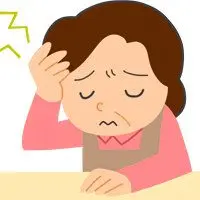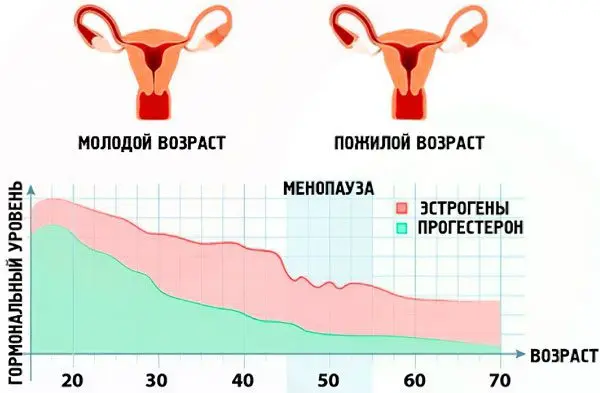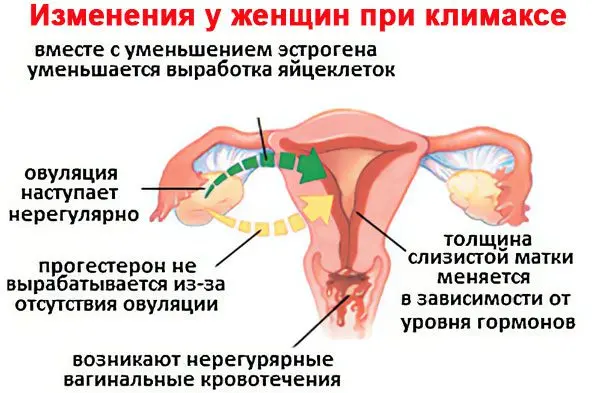Contents
- 5 very early harbingers of menopause
- Signs of early menopause in 30-40 years
- Symptoms of menopause in 40-50 years
- Features of late menopause in women aged 50+ years
- How long does menopause last for women?
- What diseases provoke menopause?
- Is it possible to get pregnant with menopause?
- How do menstruation behave before menopause?
- Is it possible to stop the onset of menopause and how?
- How to ease the course of menopause?


Menopause in women is a special period in the life of every woman, usually at 48 ± 3 years, accompanied by a decrease in the level of sex hormones and a gradual loss of reproductive function. In medicine, menopause is a chain of physiological events stretched over time.
In different sources, menopausal restructuring lasts up to 10 years. Proper organization of life, a special diet, psychological assistance, and in some cases drug therapy create a decent quality of life for a woman experiencing temporary difficulties.
The first problem a woman faces is a psychological one. During this period, changes in character were noticed, manifested by excessive irritability, suspiciousness and vulnerability. Psychologists unanimously recognize the critical age as a problem of the inner circle (husband, children, grandchildren, colleagues). A friendly, calm atmosphere in the family, at work, facilitates coexistence.
Relatives should understand that:
Menopause is not a disease – it is a new stage of life;
Natural age-related changes in appearance with menopause can be smoothed out;
The intimate sphere remains an important part of married life;
Excessive, for a third-party look, care (of mothers, grandmothers, wives), the demand for reciprocal attention, should find understanding, perhaps this is a new meaning of life.
At work, it is advisable to maintain friendly relations, leave personal problems at home.

5 very early harbingers of menopause
The approaching menopause makes itself felt with early symptoms, to which a woman, as a rule, does not pay attention. Most women report difficulties with conception, pregnancy and childbirth, and by the age of 30-40, many have chronic gynecological pathologies, endometriosis. Therefore, an unstable menstrual cycle is of little concern.
There are 5 harbingers of menopause that are mistaken for common diseases:
A change in the duration of menstruation, spotting, loss of a cycle is taken for gynecological diseases.
A decrease in the production of sex hormones causes the same symptoms.
The female cycle can be lengthened or shortened up to 2-3 weeks. Bleeding is often observed after missed periods.
PMS is characterized by more pronounced changes in the nervous system.
Sudden mood swings, development of depressive disorders are often recorded.
The appearance of the first harbingers of menopause is associated with many reasons:
Frequent stress loads.
Unfavorable environmental factors.
abortion.
Hormone therapy.
Sexual activity is determined by the hormonal background. With a drop in the concentration of estrogen, a woman feels discomfort and dryness in the intimate organs, a decrease in sexual desire.
Video: venereologist, urologist, andrologist, sexologist Ekaterina Makarova tells in an informal setting how to understand that you have menopause?
At what age does it start?
Gynecologists distinguish several types of menopause, based on the woman’s age:
Premature – 30-40 years old.
Early – 41-45 years old.
Average – 45-50 years old.
Late – 50-55 years old.
It is important to remember that early and late menopause are pathological conditions. If there are signs of a menstrual disorder, you should consult a gynecologist and undergo treatment.
Causes of early and late menopause
Early menopause is promoted, first of all, by the onset of menstruation at 10-11 years of age. The reason is that the female ovaries contain a certain supply of eggs. They are laid in the girl’s body during embryonic development. With each menstrual bleeding, the number of eggs decreases. When the reserve dries up, hormonal changes begin.
Premature menopause can be caused by:
Diseases of the ovaries.
Surgical interventions – oophorectomy.
long-term hormone therapy.
genetic predisposition.
Predisposing factors for early menopause are obesity, anorexia, starvation, and the abuse of all kinds of diets.
Heredity is the main cause of late menopause. Long-term synthesis of sex hormones favorably affects the functions of the brain, the activity of the heart and blood vessels, the mineral composition of bones, and the elasticity of muscle fibers.
With late menopause, it is important to systematically visit a gynecologist, since there is a high probability of developing severe pathologies from the internal genital organs.
Signs of early menopause in 30-40 years

Ovarian exhaustion at the age of 30 is a pathology. Immediately the diagnosis of “early menopause” is not established. At this age, the cessation of menstruation indicates the presence of a serious illness that requires serious diagnosis and treatment.
The development of early menopause at the age of 30-40 years is most often associated with a number of reasons:
Tuberculosis of the genital organs.
autoimmune conditions.
Gynecological pathologies.
Violations in the genetic apparatus.
pronounced acceleration.
External factors – smoking, the negative influence of the external environment.
A woman around the age of 30 should be suspected of early menopause if there are certain signs:
Rare menses.
Scanty periods.
Bleeding between cycles.
Unexpressed tides.
An early reduction in the production of sex hormones negatively affects both the internal systems of the body and the appearance. A woman notices the fragility of nails, hair loss, excessive dryness of the skin, mucous walls. Early wrinkles appear on the skin of the face. Calcium is actively washed out of the bones, which leads to osteoporosis.
How to avoid early menopause? Early menopause is the result of ovarian dysfunction (gonadal dysgenesis). The function of the ovaries is supported by hormones and biologically active substances. Not always early menopause can be prevented, for example, many hereditary causes are not treatable. In some cases, for the prevention of early menopause, the method of hormone replacement therapy (HRT) is used.
Early aging can be triggered by previous diseases, which can be stopped by hormone replacement therapy.
Symptoms of menopause in 40-50 years
Medical observations indicate that the average period of the physiological climate falls on 40-50 years. Small deviations of 1-2 years in one direction or another, for example, 43-44 years or 47-49 years, are not a deviation. Age can be attributed to genetic factors.
Signs of menopause after age 45:
Hot flashes.
Psycho-emotional fluctuations.
Decrease in sexual desire, sometimes – increased libido.
Features of late menopause in women aged 50+ years
Late menopause at the age of 50+ is observed in about 5% of women. Quite often, it is a sign of serious illness. Symptoms of menopause at this age are not much different from earlier hormonal changes.
In order to track the failures of the menstrual cycle, a woman is recommended to keep a diary of cycles. Now the corresponding application is available on any smartphone. Monthly monitoring helps to establish the duration of each subsequent cycle, the number of days with bleeding, the nature of the discharge. The data of the “women’s diary” greatly facilitate the establishment of the correct diagnosis.
Women over 50 report a range of symptoms:
Severe soreness of the mammary glands before the onset of bleeding.
Periodic changes in heart rate.
Increase in blood pressure limits.
Explicit dryness of the mucous membranes.
A gynecological examination determines with accuracy whether the listed manifestations are menopausal or whether they are symptoms of other somatic pathologies.

How long does menopause last for women?
The average duration of menopause is approximately 5-8 years. The time period of hormonal changes is affected by:
Genetic predisposition.
Number of births.
Smoking.
Associated pathologies.
The entire climacteric period takes place in three phases – premenopause, menopause, postmenopause.
Perimenopause. During this period, the first symptoms of the approaching menopause are recorded. As a rule, a woman does not focus on them, since the hormone deficiency has not yet been expressed. The body adapts itself to new conditions. For the first time there are failures of the menstrual cycle. Menstruation is delayed, the duration of the cycle changes. Premenopause occurs at about age 45 and lasts 3-5 years.
Menopause. The onset of menopause is established from the last menstruation for 12 months. The last menstruation is set based on the menstruation calendar. As a rule, this period falls on 50 years and is characterized by a decrease in the synthesis of hormones. A decrease in the concentration of estrogens causes an exacerbation of specific menopausal symptoms. Women complain of hot flashes, weight gain, dry and aging skin, and mood swings.
Postmenopause. After a one-year menopause, a new stage begins – postmenopause, which lasts up to about 75 years. After 2-3 years, hot flashes completely disappear, the emotional background becomes more stable. At this time, the synthesis of estrogen completely stops. Hormone deficiency leads to osteoporosis, cardiovascular pathologies.

What diseases provoke menopause?
The transformation of the hormonal status affects not only the ability of the fair sex to give birth to children. Estrogens are necessary to protect the female body from many diseases, to preserve its structures. A decrease in the level of hormones invariably entails a breakdown of all internal systems.
Against the background of hormonal transformation and developing menopause, a number of somatic diseases most often occur:
Frequent urination. The reproductive system is inextricably linked with the reproductive system, so the first to experience the negative impact of hormonal imbalance. This also includes the weakening of local protective functions and an increased risk of vaginal infections.
Myoma of the uterus. A very common disease in which multiple or single nodes are formed. The process of neoplasm starts along with menopausal changes. Quite often, single fibroids resolve after menopause.
Osteoporosis. Hormonal deficiency contributes to the disruption of the functions of the building cells of bone tissue. As a result, fragility develops, bone density decreases, and the likelihood of fractures increases.
Ovarian cysts. Against the background of menopause, women often develop endometrioid, dermoid cysts, polycystic ovaries.
Cardiovascular disorders. Climacteric processes provoke the development of arterial hypertension. The entire circulatory system suffers – from the heart to the capillaries. The likelihood of the first symptoms of ischemia, hypertension, and sclerosis increases.
Climacteric transformations always cause some problems in sexual life. Most women note a decrease in sexual desire, dryness in the intimate area. The problem is solved by using special preparations, lubricants, hormonal agents.
Age changes do not mean the onset of any disease. Compliance with the recommendations of the doctor makes it possible to minimize the negative symptoms of menopause and live an active life.
Is it possible to get pregnant with menopause?

Pregnancy occurs when a mature male reproductive cell (sperm) and a mature female cell (ovum) merge during the fertile period, which occurs approximately in the middle of the monthly cycle. In order for a successful pregnancy to occur, several important conditions must be met, including sperm activity, favorable conditions for gestation in the birth canal, uterus.
Ovulation in the initial stages of menopause can be hidden. Therefore, theoretically, the fusion of a mature sperm with an egg can occur, but in practice it is rare. It is possible to conceive and bear a fetus after artificial hormonal stimulation, but there are limitations. Stimulation is carried out after a thorough, clinical examination of the spouses. Pregnancy at a critical age is undesirable, due to the extremely high risk of genetic abnormalities in the fetus. The complete absence of menstruation for a year or more means the onset of physiological infertility.
How do menstruation behave before menopause?
Before menopause, non-ovulatory cycles are characteristic as a result of a violation of the cooperation of estrogens and progesterone. An imbalance of hormones is the cause of heavy bleeding (metrorrhagia) not associated with menstruation. Metrorrhagia is one of the harbingers of menopause. Do not confuse metrorrhagia and menorrhagia – heavy bleeding during monthly cycles.
The diagnostic sign of metrorrhagia is the detection in the blood at a high level of progesterone. In some cases, the cause of heavy bleeding is ulceration of the walls of the myometrium, rupture of the wall of blood vessels. The diagnosis is made on the basis of a gynecological examination and laboratory tests.
Is it possible to stop the onset of menopause and how?
The gradual extinction of sexual function is a physiological process that occurs sooner or later in the life of every woman. None of the representatives of the weaker sex will be able to avoid menopause. Each of the women can only suspend this process and preserve youth for a few more years. The main condition is the observance of a healthy diet, water balance, proper regimen, and abstinence from bad habits.
Adequate physical activity has a positive effect on a woman’s body. Prolongation of youth and activity contributes to regular sex life. Experts recommend constantly using vitamin complexes, drugs that promote the health of the nervous system. Stress resistance and a healthy lifestyle are the key to a mild menopause.
How to ease the course of menopause?

In order to alleviate the symptoms of menopause, it is enough to follow simple medical advice. A woman should introduce 1200-1500 mg of calcium, 800 IU of vitamin D into her daily diet.
A sufficient amount of calcium can be obtained with kefir, skim milk, red fish. To be sure to provide your body with calcium, a woman is recommended to use nutritional supplements with calcium citrate. Other combinations of calcium may contribute to flatulence. An excessive amount of calcium in the blood can provoke the development of urolithiasis.
External beauty is important for women, so special attention should be paid to the skin. In adulthood, hardware procedures, injection methods, massage for face and body skin care are recommended. They contribute to the preservation of the muscular frame, the synthesis of its own collagen. Be sure to use anti-aging creams with a UV filter throughout the year.
Psychologists have formulated several principles that help a woman cope with internal fears of menopause:
In adulthood, a woman has a certain experience, emancipation and knows what she wants to get from a man in an intimate relationship.
A lady with formed views adequately relates to life, to the people who surround her.
As a rule, by this life milestone, career success has been achieved, financial independence has been determined. Adult children live their own lives, so a woman can devote a lot of time to herself, do her favorite things, fulfill her own dreams.
To feel attractive, you should visit a hairdresser, update your wardrobe.
A woman acquires independence from surrounding opinions. It is now that she is gaining freedom, discarding old complexes.
Only an adequate attitude towards oneself, adherence to a certain daily routine help to correctly perceive the psychological and physical changes associated with menopause.
[Video] Dr. Berg – #1 Remedy for Menopause and PMS Symptoms:









